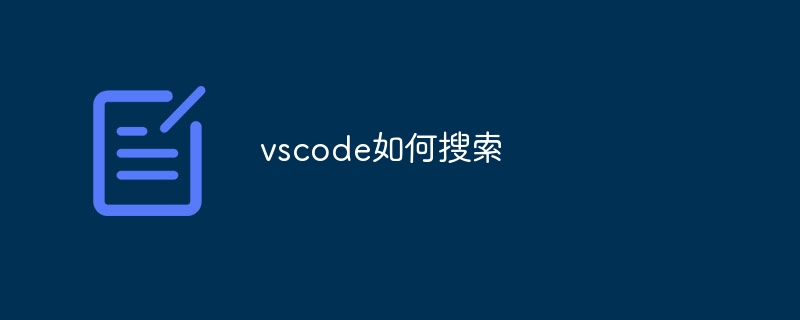How to search for vscode
Search in VSCode: Use the shortcut key Ctrl F or Menu Edit > Find. Enter the search content. Configure optional search options: full word matching, case sensitivity, or regular expressions. Click the Find Next button or press Enter to start the search. Search results are displayed in the Editor panel and the Find Results view, supporting advanced search features (Find Files, Regular Expressions, Range Search, and Symbol Search).

How to search in VSCode
VSCode is a popular code editor that provides powerful search capabilities to enable developers to quickly find specific content in their code. Here is how to search in VSCode:
Step 1: Turn on the search function
- Shortcut keys: Ctrl F (Windows/Linux) or Cmd F (macOS)
- Menu: Edit > Find
Step 2: Enter the search content
Enter the text or pattern you want to find in the search box.
Step 3: Configure search options (optional)
- Full-word matching: only match words that are exactly the same as the search content.
- Case sensitivity: distinguish search results based on case.
- Regular expressions: Use advanced search mode for complex searches.
Step 4: Start Search
Click the Find Next button or press Enter to start the search.
Search results
The search results will be displayed in the following ways:
- Editor panel: The matching line of code will be highlighted.
- Find Results View: Shows a list of all matching results. Double-click a result to jump to that location.
Advanced Search
VSCode also supports more advanced search functions:
- Find Files: Use Ctrl Shift F or the Find File command to search all open files.
- Use regular expressions: Use regular expression mode for advanced search by checking the "regular expression" option.
- Range Search: Use the "Include range" option to specify searches in a specific file or folder.
- Symbol Search: Use Shift Ctrl F or the Find All symbol command to find all code related to a given symbol.
The above is the detailed content of How to search for vscode. For more information, please follow other related articles on the PHP Chinese website!

Hot AI Tools

Undresser.AI Undress
AI-powered app for creating realistic nude photos

AI Clothes Remover
Online AI tool for removing clothes from photos.

Undress AI Tool
Undress images for free

Clothoff.io
AI clothes remover

Video Face Swap
Swap faces in any video effortlessly with our completely free AI face swap tool!

Hot Article

Hot Tools

Notepad++7.3.1
Easy-to-use and free code editor

SublimeText3 Chinese version
Chinese version, very easy to use

Zend Studio 13.0.1
Powerful PHP integrated development environment

Dreamweaver CS6
Visual web development tools

SublimeText3 Mac version
God-level code editing software (SublimeText3)

Hot Topics
 Linux Architecture: Unveiling the 5 Basic Components
Apr 20, 2025 am 12:04 AM
Linux Architecture: Unveiling the 5 Basic Components
Apr 20, 2025 am 12:04 AM
The five basic components of the Linux system are: 1. Kernel, 2. System library, 3. System utilities, 4. Graphical user interface, 5. Applications. The kernel manages hardware resources, the system library provides precompiled functions, system utilities are used for system management, the GUI provides visual interaction, and applications use these components to implement functions.
 How to run java code in notepad
Apr 16, 2025 pm 07:39 PM
How to run java code in notepad
Apr 16, 2025 pm 07:39 PM
Although Notepad cannot run Java code directly, it can be achieved by using other tools: using the command line compiler (javac) to generate a bytecode file (filename.class). Use the Java interpreter (java) to interpret bytecode, execute the code, and output the result.
 How to check the warehouse address of git
Apr 17, 2025 pm 01:54 PM
How to check the warehouse address of git
Apr 17, 2025 pm 01:54 PM
To view the Git repository address, perform the following steps: 1. Open the command line and navigate to the repository directory; 2. Run the "git remote -v" command; 3. View the repository name in the output and its corresponding address.
 laravel installation code
Apr 18, 2025 pm 12:30 PM
laravel installation code
Apr 18, 2025 pm 12:30 PM
To install Laravel, follow these steps in sequence: Install Composer (for macOS/Linux and Windows) Install Laravel Installer Create a new project Start Service Access Application (URL: http://127.0.0.1:8000) Set up the database connection (if required)
 git software installation
Apr 17, 2025 am 11:57 AM
git software installation
Apr 17, 2025 am 11:57 AM
Installing Git software includes the following steps: Download the installation package and run the installation package to verify the installation configuration Git installation Git Bash (Windows only)
 How to run sublime after writing the code
Apr 16, 2025 am 08:51 AM
How to run sublime after writing the code
Apr 16, 2025 am 08:51 AM
There are six ways to run code in Sublime: through hotkeys, menus, build systems, command lines, set default build systems, and custom build commands, and run individual files/projects by right-clicking on projects/files. The build system availability depends on the installation of Sublime Text.
 How to set shortcut keys for sublime
Apr 16, 2025 am 09:15 AM
How to set shortcut keys for sublime
Apr 16, 2025 am 09:15 AM
To set the shortcut keys for Sublime Text, follow these steps: Open the shortcut key settings file Key Bindings - User. Add shortcut key settings using the format { "keys": ["key combination"], "command": "command" }. Save changes. Reload the shortcut key settings for the changes to take effect.
 How to set important Git configuration global properties
Apr 17, 2025 pm 12:21 PM
How to set important Git configuration global properties
Apr 17, 2025 pm 12:21 PM
There are many ways to customize a development environment, but the global Git configuration file is one that is most likely to be used for custom settings such as usernames, emails, preferred text editors, and remote branches. Here are the key things you need to know about global Git configuration files.






